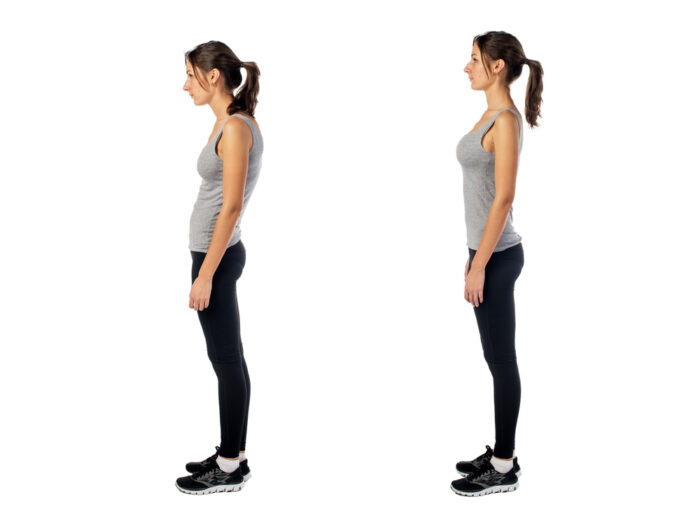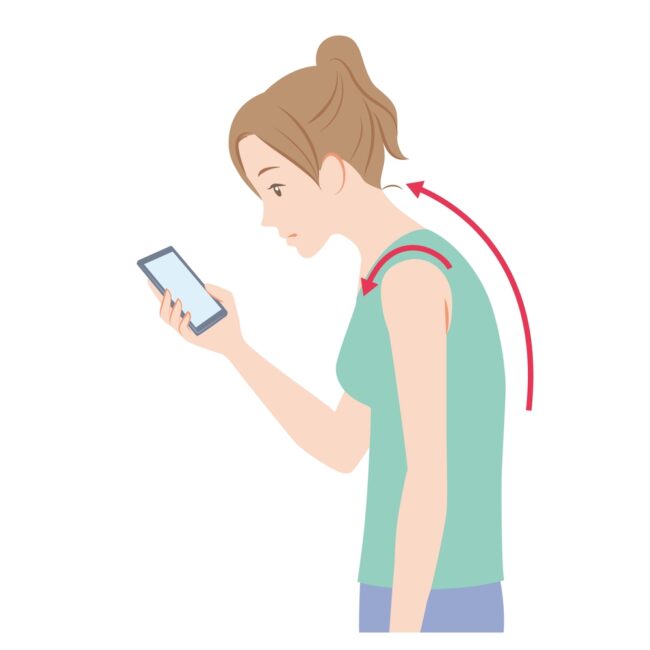
Standing up straight
Have you ever wondered if you would wind up like your grandma, or the senior citizen who is stooped over and shuffling across the street? You might have commanded yourself to sit up straight and practice good posture in order to avoid the fate of this older person you hope never to become.
How did grandma’s body shrink and why is she looking at the ground instead of straight ahead?
Rounding of the upper back
Forward rounding of the upper back is often referred to as hunchback or Dowagers Hump. The medical term is dorsal kyphosis. Kyphosis is an exaggerated, forward rounding of the back that can occur at any age but is most common in older women.
One thing is certain, while cell phones and text messaging do put a great strain on the upper back neck and shoulders, they are not what lead to grandma’s hunchback. No doubt about it, as we sit with our heads drooping forward and our upper back rounded, we are compromising our spines.
Poor posture has a price

Over time, poor posture leads to overstretching of the ligaments and muscles that support the vertebrae. Laxity of the strap like paraspinal muscles, ligaments and other supporting tissues that run along either side of the spinal column give way for the spine to move from the vertical to the horizontal plane. As the support system for the vertebrae becomes over stretched the bones can move out of alignment , resulting in a kyphotic spine and predisposing one to pain, poor circulation, breathing issues, herniations, arthritis and other unwanted conditions.
Poor posture in childhood, such as slouching, leaning back in chairs and carrying heavy school bags, can also cause the ligaments and muscles that support the vertebrae to stretch. This can pull the thoracic vertebrae out of their normal position setting the stage for kyphosis.
Childhood is a perfect time to develop good postural habits and monitor the book bag burden. Early interventions, including Rolfing, can save a lot of children from developing age-related postural kyphosis later in life.
Osteoporosis can lead to compression and deterioration of the spinal bones. This degeneration of the vertebrae may have caused grandma’s upper spine to round forward and lose it’s vertical alignment.
The more the spine moves off center, the greater the energy and muscular effort required to hold oneself up. For every inch that your head protrudes forward from its normal alignment, you add approximately an extra 10 pounds of force to support your head upon your neck.
This extra effort causes pliable soft tissue structures to harden as one works against gravity to keep their head up resulting in bracing, tension and pain. As soft tissue structures solidify, muscles, fascia and soft tissue of the entire upper trunk lose their ability to move. The upper trunk becomes wrapped in a tight soft tissue corset making it impossible to stand erect. Deep breathing which requires rib, diaphragmatic and spinal movement is hindered. Kyphosis is also associated with tight chest and hip flexor muscles.
Structure plays a key role
Making attempts to sit and stand up straight are a good beginning, however as soon as your mind moves onto the next thought your body is likely to resort to its habitual posture. Our structure plays a key role in our posture. While our bodies are a collection of parts (muscles, bones, organs) what keeps these parts together and in relationship to each other, is the fascia or connective tissues. When you look at a person’s posture, you see the underlying relationships that are set in the structure. Shortenings within the structure have a direct and constant influence on posture. Tight, shortened pectoral muscles do not allow the shoulders to come back and the chest to open. Shortened inflexible paraspinal muscles do not allow the spine to extend and the head to sit comfortably on top of the spine.
During the 1920’s Ida Rolf, a young biochemist, began to see the important role that fascia plays on the shape of our bodies as well as posture. Over decades of research and practice she explored the vital role fascia plays in how our bodies are shaped by our experience. How we used our bodies in both work and play, the injuries, surgeries and illnesses we have endured and emotional history all determine our structural pattern and shape. Rolf began with the insight that fascia is not unyielding but can change with manual manipulation. This premise gave birth to Rolfing also known as Structural Integration.
Rolfing can help bring a kyphotic spine back on to its vertical axis. By balancing the tensions in the soft tissue network, Rolfing realigns the structure and provides the framework for an upright posture. Rolfing helps us to avoid developing a hunched posture.
